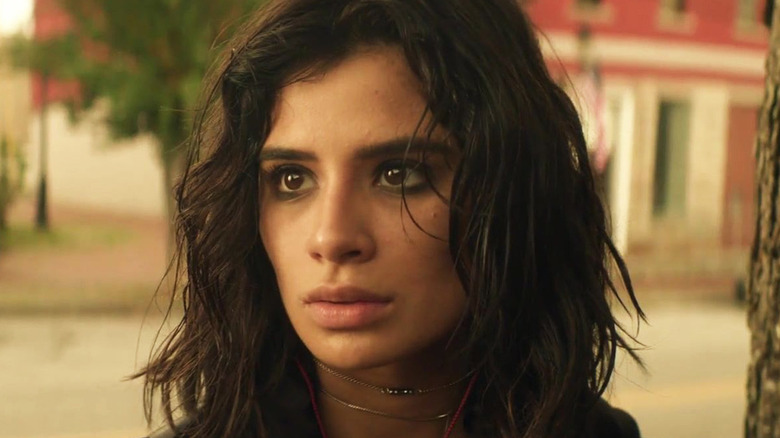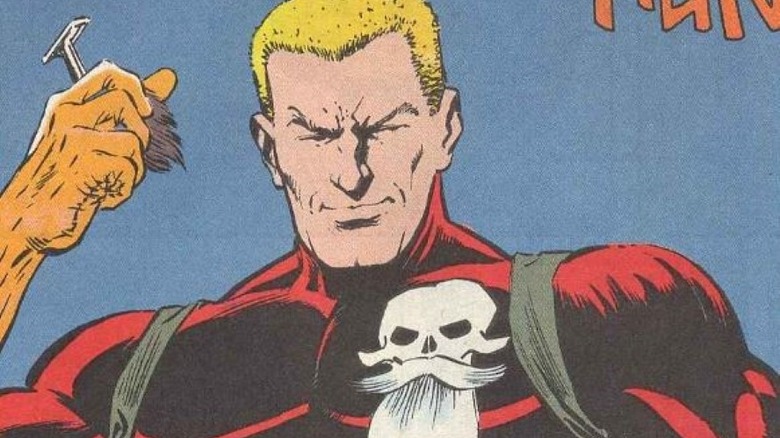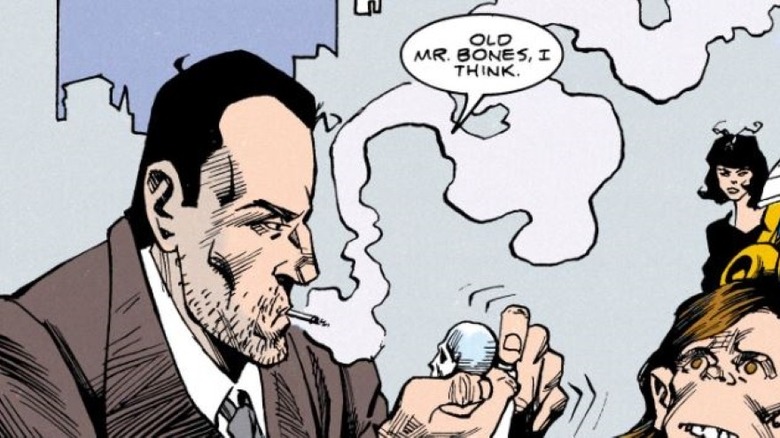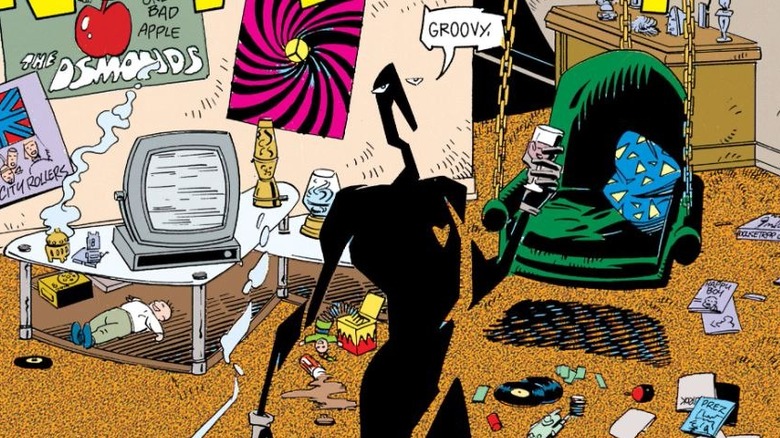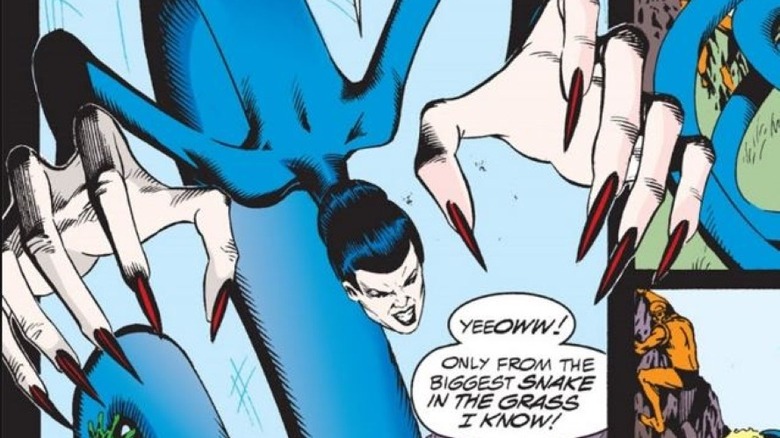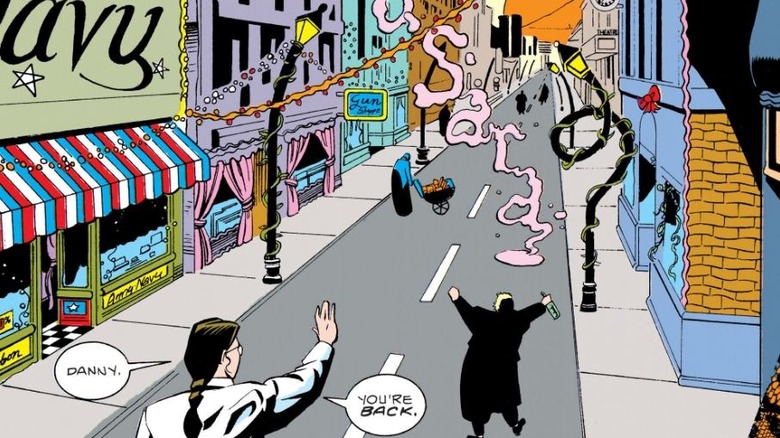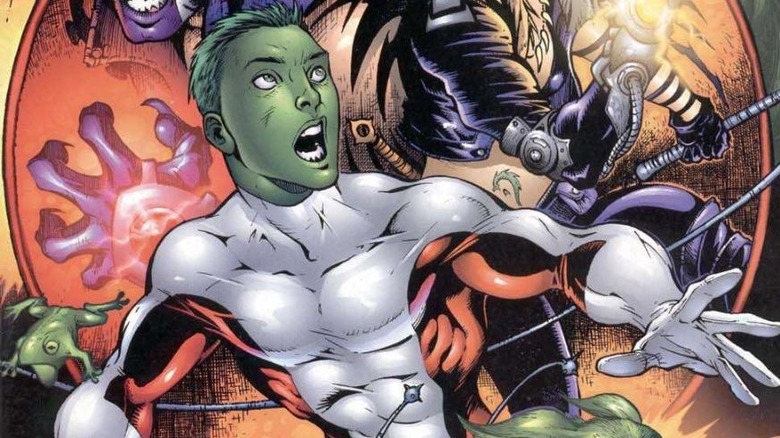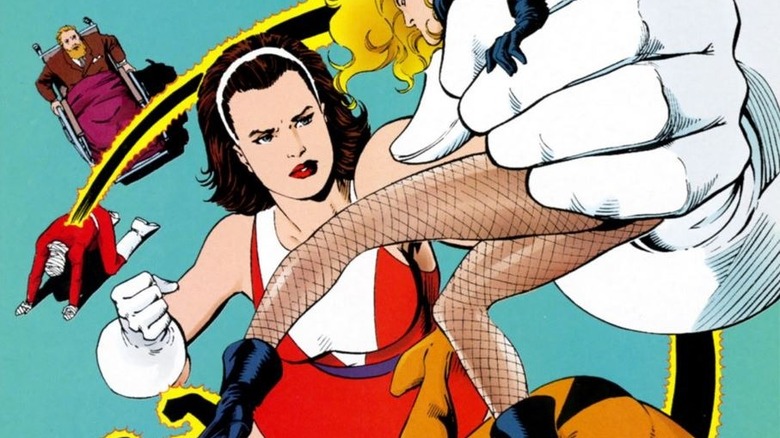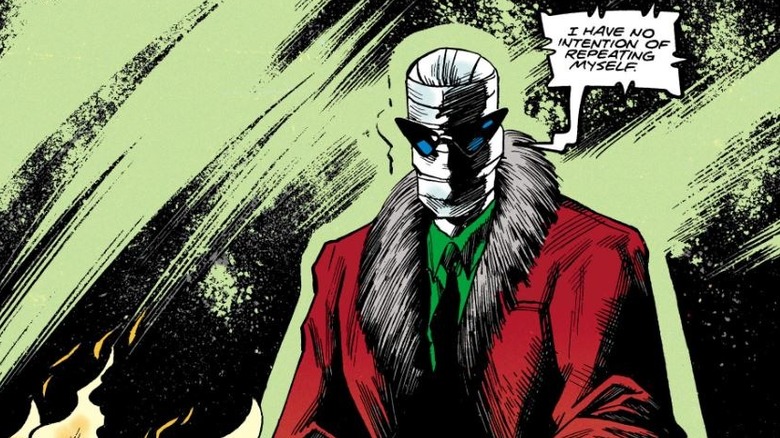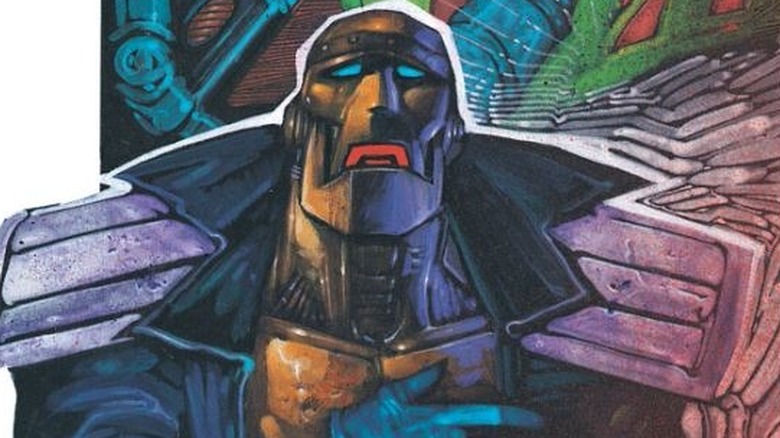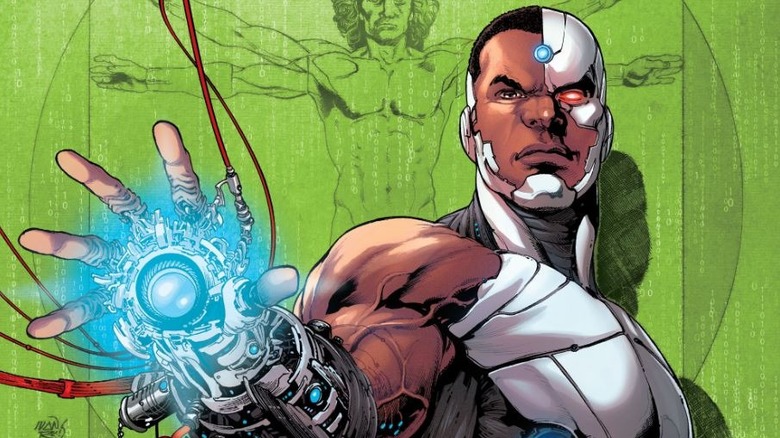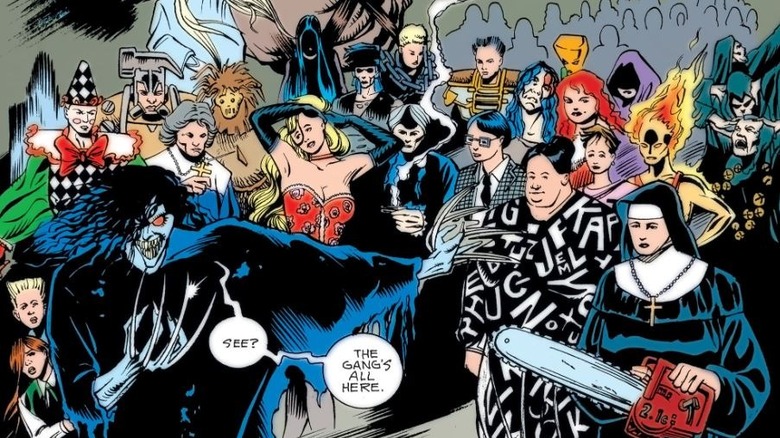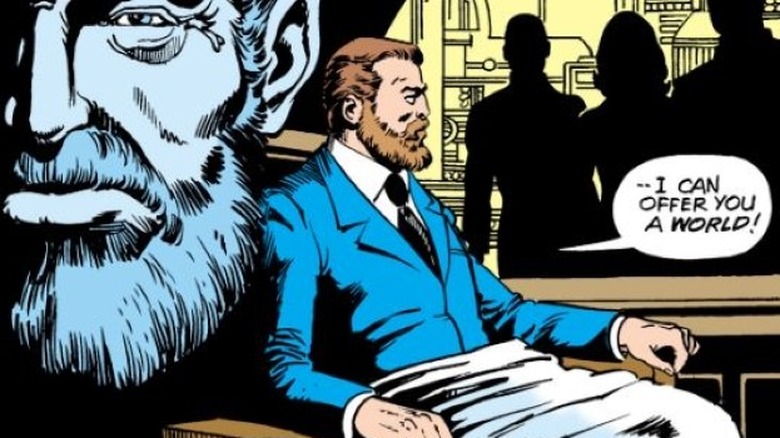What The Doom Patrol Cast Should Really Look Like
The Doom Patrol is many things, but above all, it's a truly one-of-a-kind superhero team. This band of do-gooders has a long history of harboring misfits, tackling bizarre villains, and otherwise doing things their own way. These heroes were boosted up to a new level of prominence when they landed "Doom Patrol," a live-action series of their very own, back in 2019. But their history goes back much farther than that recent year. First appearing in 1963's "My Greatest Adventure" #80, the Doom Patrol has maintained a consistent stream of titles and stories throughout the decades. While the quirky squad has never attained the fame A-list teams like the Justice League and the Teen Titans enjoy, that's okay with them. The Doom Patrol's off-the-beaten-track nature is what makes the team so special — and it's proved to be the secret to the TV show's success.
Fans of the live-action series have fallen in love with these out-there characters. But even diehard devotees might not realize how different Robotman, Madam Rouge, Mr. Nobody, and other "Doom Patrol" characters appear when compared to their ink-and-paper incarnations. Curious about how your favorite oddballs appear in the source material? Then keep reading. We're taking a look at what the "Doom Patrol" cast should really look like.
Beard Hunter
One of the most cringe-worthy characters to appear on "Doom Patrol" is the facial hair-obsessed Ernest Franklin, also known as Beard Hunter. First grossing audiences out in the Season 1 episode "Hair Patrol," Beard Hunter (Tommy Snider) isn't shy about putting his uniquely grotesque gift on full display. Ingesting a single piece of a person's facial hair grants Ernest the ability to connect with the stranger. He becomes able to locate them and see everything that they've seen. As the character himself puts it, "Facial hair connects me to the secrets of the universe. It's the ultimate flavor savor." Even among a cast full of weirdos, Beard Hunter is inarguably one of the strangest characters on "Doom Patrol."
Beard Hunter has some deep comics roots, being co-created by Grant Morrison, one of the industry's most influential names. While still intended as a comedic villain, Beard Hunter of the comics is more dangerous and much darker than his on-screen counterpart. He looks the part, too: The original Beard Hunter is fanatical about bodybuilding, which gives him a buffer physique than TV's Beard Hunter. The comics' version sports a red costume that bears an obvious resemblance to Marvel's Punisher, but with shorn goatees filling his belt in place of ammo. Notably, the comic character does not share his TV incarnation's disgusting superpower — rather, he's an ordinary man with a psychotic obsession with collecting people's beards as trophies.
Willoughby Kipling
Willoughby Kipling is an unrefined master of mysticism. Brought to life on screen by Mark Sheppard, he's a regular inclusion throughout the entirety of the "Doom Patrol" series, primarily dealing with issues of the occult. A member of the Knights Templar, the foul-mouthed magician is particularly instrumental in the Season 2 fight against the Candlemaker.
The comic book version of Willoughby Kipling and his on-screen counterpart have similar origins. In the pages of DC Comics, he is also a magician of the Knights Templar who fights against the Candlemaker. However, if you can believe it, Kipling of the comics is even more coarse. This is made especially clear by the fact that he's consistently depicted with a cigarette and a glass of whiskey in his hand. A slim, dark figure with permanent stubble, this Kipling can't help but remind readers of another mystic trouble-shooter: John Constantine. By far the most significant visual difference between TV Kipling and comics Kipling is the latter's unusable skeleton arm, which is a result of his fight with the Candlemaker.
Mr. Nobody
Mr. Nobody is anything but a nobody. This character debuted all the way back to 1964's "Doom Patrol" #86 as the mysterious Mr. Morden. His TV counterpart is a truly impressive figure: Boasting near-omnipotent powers, Mr. Nobody (Alan Tudyk) is able to warp time and reality. This causes no end of confusion for the Doom Patrol, especially in Season 1. The fourth-wall-breaking antagonist is eventually trapped in a painting referred to as the "White Space."
In the comics, Mr. Nobody is every bit as intimidating — but visually, he's vastly different and uniquely ambiguous. This isn't always the case, granted: In his first battle with the Doom Patrol, he looks like an average human criminal. But then, he's exposed to a Nazi experiment known as the "White Room." This hideous invention turns him into a living shadow. Typically drawn as a twisted, almost Picasso-esque human figure rendered in flat black ink, this Mr. Nobody is particularly distinguished by the heart-shaped hole in his chest. Later on, the character re-emerges as Mr. Somebody. In this guise, he's still a bizarre humanoid figure with a missing heart, but he's rendered in pure, ghostly white. While he no longer looks like a literal shadow, this incarnation might be even creepier.
Madame Rouge
Laura De Mille (Michelle Gomez), better known as Madame Rouge, arrives in Season 3 of "Doom Patrol." A reformed supervillain, this time-travelling femme fatale is immediately memorable. But history has a way of sticking around, and Madame Rouge's fiendish past is poised to come back and bite the team where it hurts.
Madame Rouge casts a long and menacing shadow in the comics. She's been a thorn in the Doom Patrol's side since the 1960s in a wide variety of ways. Traditionally, this veteran metahuman has worn a striking ensemble of banded metallic leggings, knee-high boots, elbow-length gloves, and a dark blue leotard. Everything she wears appears to be constructed of a rigid material, to the point that it resembles armor. This is in striking contrast to her elastic superpowers, which allow her to stretch, contort, and otherwise transform her flesh into any shape she likes. You might expect her to wear a lot of red, given her name. Madame Rouge of the "Doom Patrol" TV series is certainly associated with that hue, often donning cherry-red outfits and accessories. But Madame Rouge of the comics doesn't typically wear red, save for the occasional manicure. She also lacks the TV incarnation's retro flair.
Danny the Street
Another unique creation from celebrated "Doom Patrol" writer Grant Morrison, Danny the Street is a sentient urban roadway. Even in a medium full of memorably bizarre characters, you have to admit that this stands out as an especially original concept. But bricks and storefronts aren't the only things that make Danny the Street such a one-of-a-kind character: This conscious setting identifies as genderqueer. A kind-hearted being who thrives off the joy of others, Danny is an excellent friend, a compassionate listener, a wonderful host, and a truly snazzy walkway.
In the comics, Danny undergoes many transformations. At different points, they've been a street, a theme park, a brick, and an ambulance. Surprisingly, the TV series matches many of these incarnations: Danny has also been a street, a brick, and an ambulance on the small screen. Many vivid details of their ink-and-paper self make the jump to TV as well: Danny features flower-filled and frilly hardware stores on both the page and screen. Their ability to communicate through billboards and signage is also represented in both incarnations. Most TV shows would have toned Danny's unique details down in the process of adapting them. But as fans know, "Doom Patrol" isn't most TV shows.
Beast Boy
Most fans of the "Doom Patrol" TV series are aware that these characters made their debut on "Titans," another DC-based TV show. Specifically, they headline Season 1's aptly-titled "Doom Patrol." While viewers might not have heard of Robotman or Crazy Jane when this episode first hit the airwaves, one name was probably familiar: Beast Boy.
Beast Boy has a long history with both the Doom Patrol and the Teen Titans. He's become best-known as a member of the latter group, thanks to the beloved "Teen Titans" and "Teen Titans Go!" cartoons. In both of these shows — and most "Teen Titans" comics — he serves as jaunty comic relief. This makes him an invaluable part of the 2018 "Titans" series. But the shapeshifter is just as vital to the identity of the Doom Patrol. Typically the youngest member of the group, he has a long history of serving as the Doom Patrol's earnest heart.
In many ways, the live-action Beast Boy (Ryan Potter) looks a lot like his comic incarnation. They're both energetic young men who wear a lot of red and white. But one difference is immediately obvious: Comics Beast Boy has bright green skin, while TV Beast Boy has bright green hair. As both "Teen Titans" cartoons portray the shape-shifter with an emerald-hued epidermis, this is a major departure. Still, it's hard to look at the live-action Beast Boy and mistake him for anyone else.
Elasti-Girl
Not to be confused with the Pixar character of the same name, Rita Farr, aka Elasti-Girl, is an original member of the Doom Patrol. Appropriately, she's an integral part of the "Doom Patrol" TV series. Depicted by April Bowlby, Rita is the first teammate to take up residence in Doom Manor as Niles Caulder's apprentice. Once a renowned starlet of the silver screen, Rita becomes deformed on the molecular level by a mysterious toxic gas. She comes to act as a motherly figure to the misfits of the Doom Patrol and appears in every episode of the live-action series.
Rita is just as glamorous in the comics as she is on the TV screen. But while TV Rita is a fashion plate with a wide variety of sharp outfits, comics Rita favors classic superhero garb over haute couture. Traditionally, she wears red and white costumes; her '60s-style minidress, often accompanied by purple accessories, is especially memorable. She also favors headbands, gloves, and high-heeled boots. Sartorial taste isn't the only difference between the two Ritas: The comics' version of the character is far less timid than the one who appears on the TV show. This tenacity doesn't always work out well for the stalwart Elasti-Girl, however: In the comics, she and her teammates heroically sacrifice themselves to save the residents of Codsville, Maine. Don't worry too much on their behalf, though — in true DC Comics fashion, they all end up getting resurrected.
Negative Man
Lawrence "Larry" Trainor, also known as Negative Man, is another original member of the Doom Patrol who has stuck with the team for decades. His origins and powers are a central part of the "Doom Patrol" TV series, from his time as an Air Force pilot to his career as one of the team's most influential players. A disgruntled and angry soul, Larry (Matt Bomer) is forced to live his life entirely covered in thick bandages or inside a lead-lined bedroom. If he deviates from either path, he risks infecting everyone around him with deadly radiation. This doesn't keep him from getting the job done, however: Negative Man is one of the team's heaviest hitters. This is all thanks to his "Negative Spirit," an immaterial being who can leave his body behind, travel between dimensions, phase through solid matter, and possess both people and objects.
Larry was probably the simplest "Doom Patrol" character to adapt for the small screen, thanks to his signature bandages. Both the ink-and-paper and small screen versions of the character don these white wrappings. Similarly, both characters are often seen wearing their old pilot's jacket. However, in the comics, Negative Man is also known to wear a standard superhero costume with the red-and-white color scheme that distinguishes the Doom Patrol. Additionally, while his Negative Spirit is depicted as a glowing blue nervous system on the TV show, it's depicted as a black and yellow figure in the comics.
Robotman
Robotman (Brendan Fraser) is one of the most lighthearted and dynamic characters on "Doom Patrol." This is incredibly ironic, given that he's also a cold metal robot who cannot physically emote. And yet, this never stops him from being a warm and friendly ball of charisma. A former racecar driver, Clifford "Cliff" Steele is grievously injured by a terrible crash. It's the sort of disaster that would kill any other man — but Cliff's circumstances are unique. The Chief saves his brain and puts it in a shiny metal body. Gaining another chance at life — even though he's not always jazzed about its circumstances — slowly turns Robotman into a big softy.
Cliff Steele's on-screen look is impressively reflective of the source material. As in the comics, he's a bronze robot with blocky features, held together by big, round rivets. Both versions have a bit of a banged-up look about them, and a retro edge — their synthetic bodies bring "The Jetsons" to mind. They also share a fondness for punk rock, evident in their black leather jackets and slogan-heavy T-shirts. As one of the Doom Patrol's most memorable members, Robotman has been illustrated by plenty of artists. However, many elements of his design have remained relatively identical over the years, which makes his TV incarnation's faithfulness all the more satisfying.
Cyborg
Easily the most recognizable character on "Doom Patrol," Cyborg, aka Victor Stone, has a long and illustrious history within the pages of DC Comics. A front-line member of major superhero teams like the Justice League and the Teen Titans, the character has appeared in everything from the 2017 "Justice League" movie to episodes of "Smallville" to kid-friendly cartoons like "Teen Titans." If you go up to someone who was a kid in the '00s, odds are, they'll know who you're talking about if you ask them which character is known for exclaiming "Boo-yeah."
Though it doesn't have the budget of a silver screen project like "Justice League," the "Doom Patrol" TV series manages to capture Victor Stone (Joivan Wade) is all his glory. One difference between this Cyborg and that of the comics is immediately obvious: The half-robot, half-human young man of the small screen has fewer computerized parts than his comics counterpart. After this, the most noticeable difference between the two is the TV version's slimmer physique. In the comics, Victor is distinguished by his noticeably bulky musculature, which hearkens back to his history as a high school athlete. Moreover, many of the comics character's signature weapons, like his gigantic sonic cannon, are yet to be showcased in the live-action series.
Crazy Jane
The character known as Crazy Jane is one of the more prominent personalities of Kay Challis, a woman living with dissociative identity disorder. On the "Doom Patrol" TV series, she's primarily portrayed by Diane Guerrero. But some of the character's other personalities are represented by different performers: Stephanie Czajkowski, for example, portrays Hammerhead in the "Underground," aka Jane's mind. Sound complicated? That's only half of it. Every single one of Jane's personalities — she has 64 in total — has a unique superpower, which range from fireball-throwing to teleportation. They take turns occupying her body.
While the "Doom Patrol" TV show has done its best to showcase every last fragment of Jane in episodes such as "Jane Patrol," the comic books have been able to document far more versions of the complex character. Still, the TV show does an admirable job of bringing her to life. There are some significant visual differences between Jane of the comics and Jane of the TV show: The former sports heavily rouged cheeks and curly hair with bangs, giving her a bit of a demented baby doll vibe that the latter lacks. But both incarnations are brunettes who favor dark clothing with more than a few threadbare patches.
Chief Niles Caulder
What would the Doom Patrol be without its undisputed leader? Niles Caulder, aka the Chief, not only helps to bring the super-group together, he funds and houses all his misfit mentees. Portrayed on the "Doom Patrol" TV series by Timothy Dalton, the legendary actor perfectly embodies both the character's caring nature and his intriguing ambiguity.
In terms of visuals, Dalton's portrayal is strikingly similar to that of the comics. Both versions of Niles Caulder are older men with rugged beards who use wheelchairs. They also share an ineffable air of authority and experience that accompanies them wherever they go. But the TV version of the Chief is a tiny bit less stuffy-looking than the comics version: While the former favors button-down shirts and well-tailored coats, he doesn't live in neckties or three-piece suits, like the latter does. The TV Chief also sports a distinctive necklace, which is, in fact, a mystical longevity talisman.
